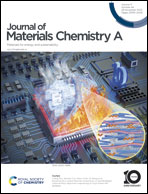High-throughput computational discovery of 3218 ultralow thermal conductivity and dynamically stable materials by dual machine learning models†
Abstract
Materials with ultralow lattice thermal conductivity (LTC) continue to be of great interest for technologically important applications such as thermal insulators and thermoelectrics. We report an efficient workflow combining high-throughput density functional theory (DFT) computing and two different types of machine learning (ML) models for fast and accurately screening ultralow LTC from large-scale inorganic crystals. Firstly, we train seven classification ML models on 8077 data obtained from high-throughput full DFT calculations to classify 50 574 structures into positive and negative dispersions, among which 22 899 structures are dynamically stable. Secondly, with 4041 high quality LTC data, we train three graph neural network prediction models to predict LTC. The LTC ML models are verified on 359 randomly selected structures. Our ML model successfully predicted 90% of 359 structures to possess ultralow LTC (less than 1 W m−1 K−1). An additional 3218 structures with ultralow LTC are also predicted and provided. With further analysis of the correlation between LTC and material features, we identify two excellent material descriptors, that can be evaluated with low computational cost for efficient screening of ultralow LTC: the large P3 parameter which represents a large number of three-phonon scattering channels and the large thermal mean squared displacement which reflects the soft phonon modes in the lattice usually resulting in strong phonon anharmonicity. Our workflow integrating dual ML models offers a new route to accelerate the discovery of novel dynamically stable materials with a high success rate for predicting effective lattice thermal conductivity.



 Please wait while we load your content...
Please wait while we load your content...